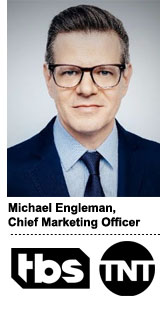
Turner Broadcasting’s new CMO, Michael Engleman, is on a mission to make TBS and TNT’s brand marketing engine much more agile.
Engleman, who helped rebrand the Sci Fi Channel as SyFy during his time at NBCUniversal, thinks broadcasters will be forced to adapt as new content producers and channels compete for consumer attention.
For years, entertainment marketers would focus on driving viewers to big opening nights, hoping to build momentum to drive more business, Engleman said.
But those days are over, and Engleman must build mindshare for Turner’s properties in a social and digital world.
Engleman spoke with AdExchanger about Turner’s evolving multiplatform marketing effort.
AdExchanger: At your last upfront, Turner’s president said TBS wasn’t just TV. It was omnichannel. Has that created a new learning curve for you?
MICHAEL ENGLEMAN: We think about marketing much differently today. We’ve shifted from a demographically minded process to a psychographically minded process.
Rather than broadcasting to consumers, it’s building relationships with fans, using data tools and audience development to build relationships with individuals at scale.
We will continue to think about how entertainment is being redefined, and ways we can extend the IP of the shows we’ve launched in the last couple years beyond just a half-hour or hour-long format.
What’s changed most about your job?
What’s changed most is a fan’s relationship to content and all the access points that they have to that content. We need to think about creating a frictionless ecosystem for both the casual viewer and for the fanatic, who wants a social and digital ecosystem built around that programming that has no dead end.
How do you use data differently now?
I feel much more proficient today than I did years ago, and that’s partly because we work with a lot of smart agencies and we have a lot of data scientists under one roof.
Data certainly has been a really significant learning curve in our industry, especially in the ad-supported [broadcast] space where we used to be so reliant on our own platforms. Now we need to go find these fragmented audiences across a lot of devices and places and spaces. We need to be much more behaviorally minded than ever before.
What was critical for Turner – TBS and TNT, in particular – was we brought our own strategy team in-house and my right hand [who] runs our strategy group is very data-oriented. I would say where we’re successful is when we can distill complexity into something simple.
Where do you still struggle?
Information overload and this real inability to unite data points from social platforms, panel testing, smart TVs and our own primary research into singular insights that are actionable. Three or four years ago, a lot of marketers had too much data but didn’t have a mechanism to extract purpose and direction from it.
So we’ve really worked at understanding what tools help us not just identify audiences, but course correct and iterate. I remember those days when we would set a course a few months out and you had certain markers you watched. Maybe you made some minor adjustments.
But today we iterate day in and day out. Data helps us find audiences and refine our messaging. Art leads when it comes to creating the content, but data helps us understand the path to consumption.
Someone mentioned to me that the biggest spender on TV – once connected and over-the-top TV scale – will be TV advertisers. Do you agree?
We have shifted money from television to digital, but I’m still a big believer in television as a huge scale and awareness play. When I’m trying to drive viewership within linear set-top box VOD, nothing beats television advertising.
But we’ve certainly shifted a lot of budget to digital and social. We know audiences are more likely to connect with our content if we reach them on multiple platforms and sequence that appropriately and customize the message.
How does that play into your larger cross-platform strategy?
A lot of people are watching television on multiple devices, so we’ve shifted a lot of money into direct-response advertising so we can convert a user through a Facebook mobile phone ad to the TBS app, without friction. The goal is to have a frictionless path to our ecosystem of apps and properties.
We also partner with a lot with the MVPDs and do big promotional platforms [using] sophisticated set-top box technology from Comcast and others.
What about digital partners like Facebook or Google?
This year, we’re looking at our digital counterparts [like] Facebook, Google and Twitter not just as social platforms for advertising, but how we co-produce together and how our advertisers benefit.
So much of what we’re thinking about is content marketing, storytelling and ways to bring advertisers along for the ride as we distribute content across social platforms and partner with them to create rich data sets.
We [also want to] recruit consumers into our owned-and-operated properties, where we can monetize them fully. The difference is thinking like producers or entertainers who have audience development and advertising in mind, but trying to create good experiences for ad-adverse 20- and 30-year-olds.
Interview condensed for clarity and length.
This post was syndicated from Ad Exchanger.

More Stories
The Trade Desk’s OpenPass Adds Rewards As It Pursues Wider Adoption
NZME’s work recognised at INMA Global Media Awards
Leading Brand Transformation: A Masterclass With Doug Zarkin